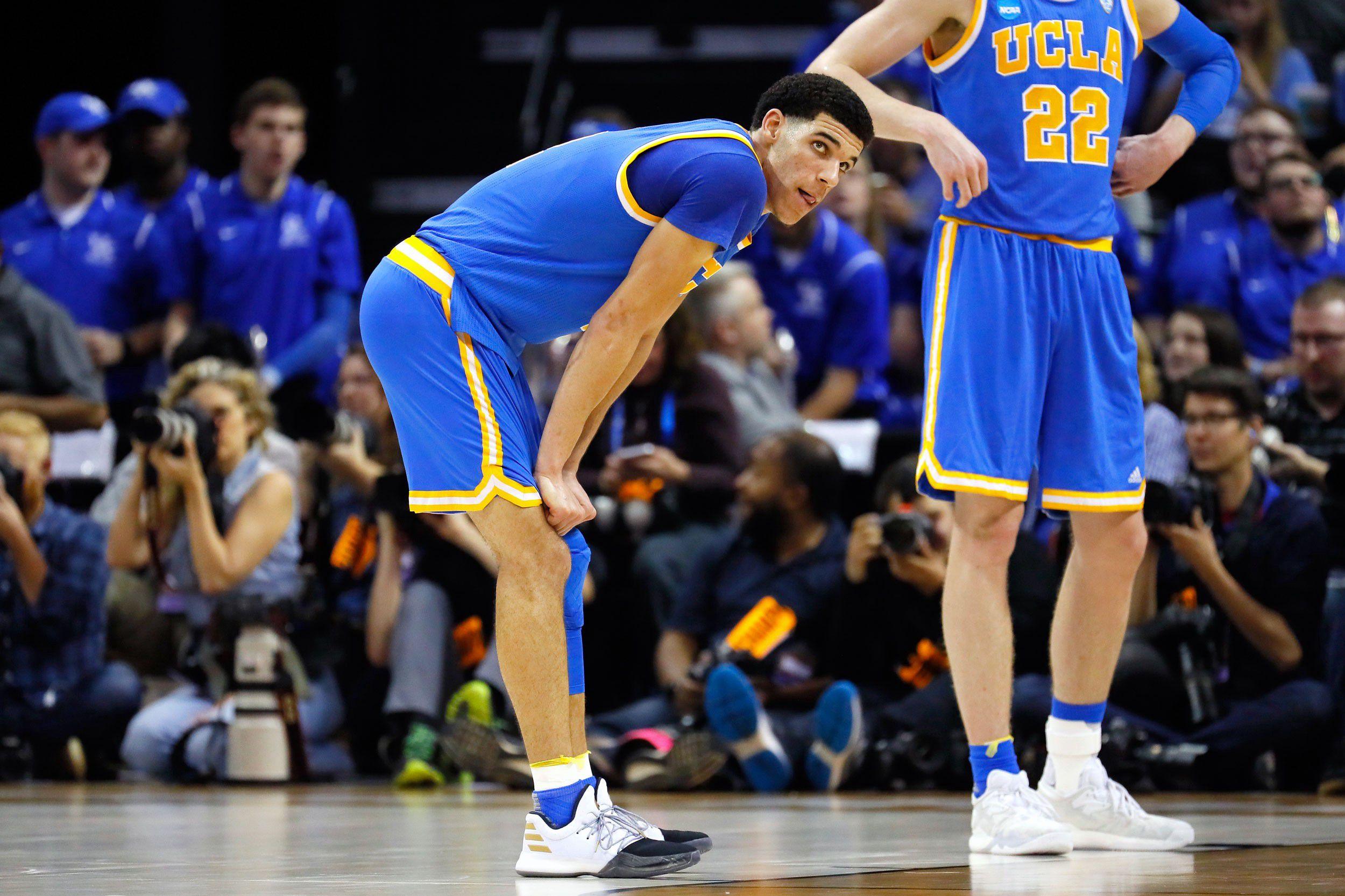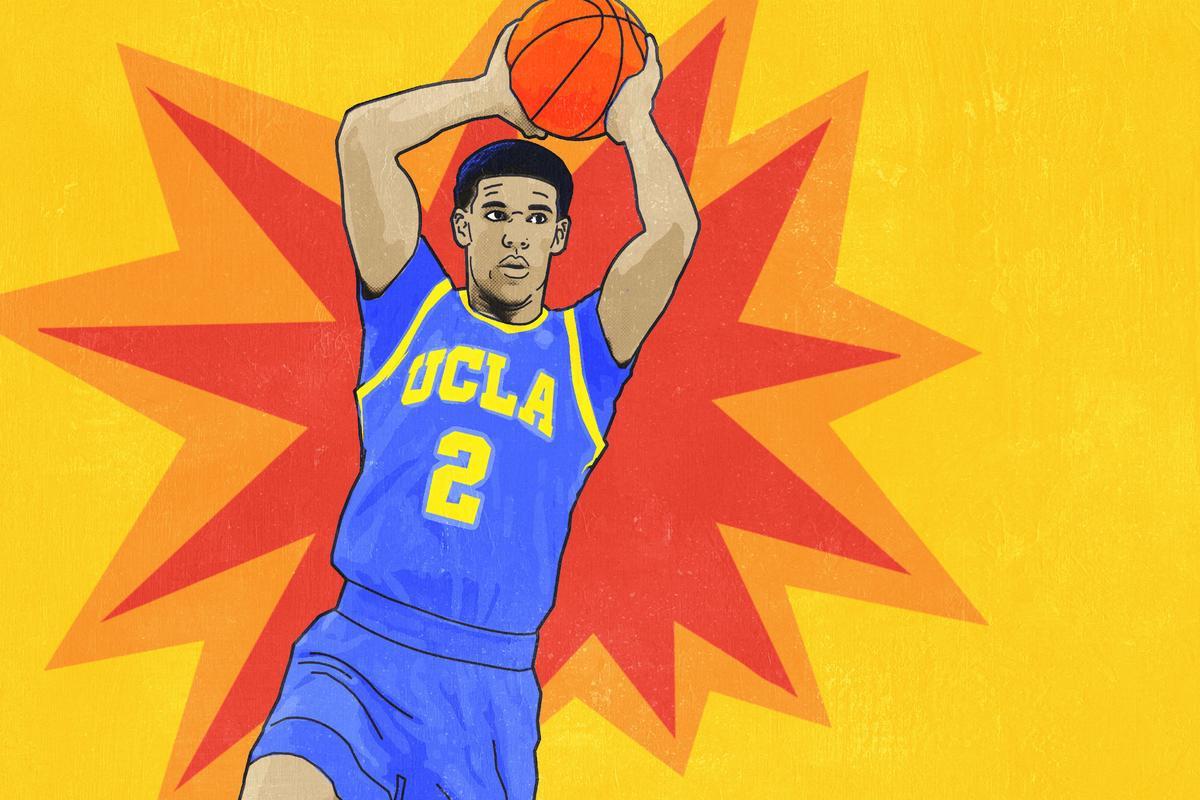Let’s talk about Lonzo Ball. No, you’re thinking of the wrong guy. I don’t mean the bald dude with the mustache who does some sort of performance art every time he gets in front of a camera. That’s LaVar Ball, Lonzo’s dad. And I don’t mean the kid who cherry-picked his way to 92 points in a high school game and has since become one of the most hated 15-year-old athletes of all time. That’s LaMelo Ball, Lonzo’s younger brother. And just to make sure we’re on the same page, I also don’t mean the redheaded woman who invented comedy when she stuffed chocolates in her bra in the 1950s (Lucille Ball) or the British politician who got 95,000-plus retweets by tweeting nothing but his own name (Ed Balls). I’m talking about the guy who resurrected the most storied program in college basketball, turned the sport on its head for an entire season before earning consensus first-team All-American honors, and seemed like a lock to be a top-two draft pick as recently as three months ago.
I want to talk about that guy, because over the last few months the narrative surrounding Lonzo has had little to do with his basketball-playing ability and everything to do with the reality show that his family has become. The guard who averaged 14.6 points and 7.6 assists per game last season while shooting 55.1 percent from the field and leading UCLA (who went 15–17 in 2015–16) to a 31–5 record has somehow gone from being a fascinating prospect to a name for talking heads to scream at one another and a cog in whatever clusterfuck of a branding machine his father is building.
Let’s recap some of the Lonzo story lines that have circulated since March: His father went on First Take and shouted for 20 minutes on March 23. The next night Ball was "owned" by Kentucky’s De’Aaron Fox in the Sweet 16. Three days after that, LaVar returned to First Take, this time with Lonzo. One day later Ball made headlines for saying that he is better than Markelle Fultz. Nike, Adidas, and Under Armour all passed on him for shoe deals, so he released $495 sneakers under his father’s Big Baller Brand. Then the Lakers finished second in the draft lottery, and LaVar went on FS1’s version of First Take to guarantee that the team would make the playoffs in Lonzo’s rookie season if it drafted him. Lonzo has since declined an invitation to work out for the Celtics (who hold the top pick in the draft) and reportedly showed up to his Lakers workout out of shape.
Before I go further, let me pause to mention that the NBA has collectively reached a point where things happening off the court are discussed just as often as the games themselves. Part of this is because the on-court drama has become drastically less interesting in the age of superteams, when it was a foregone conclusion that the Warriors and Cavaliers would meet in the Finals. And part of it is that while the league has long turned its top talents into borderline mythical figures, the obsession over their every move has reached a new level in recent years. Knowing teams’ strengths and weaknesses isn’t enough for even casual NBA fans anymore. They also have to know about The Decision, the banana boat, Paul Pierce’s rocket emoji, Draymond Green’s Snapchat, the Kardashian Curse, the Lil B Curse, My Next Chapter, I’m Coming Home, the Brooklyn picks, the Process, the Harden trade, Bird rights, Kobe’s Musecage, and Joel Embiid’s entire existence.
This phenomenon has naturally translated to the draft, spurring criticism of John Wall’s dance moves and the questioning of prospects for their love of the game. But what is happening with Ball feels unprecedented. It’s been virtually impossible to hear about Lonzo without hearing LaVar’s name mentioned immediately afterward. Some argue that LaVar will forever be a distraction and that NBA teams should be wary of drafting Lonzo due to him. Others say that the LaVar talk is being blown out of proportion and that Lonzo has a healthy perspective on everything. The reality is that the conclusions being drawn don’t matter. What matters is that the qualities that made Lonzo special in the first place have been forgotten, to the point that the Lakers are reportedly questioning whether they should take Ball with the second overall pick.
Above all else, I’m left wondering how we got here. Does anyone remember what Lonzo did on campus? Did anyone else watch him topple Oregon in the most dramatic way possible? Has any NBA prospect ever seen his draft stock impacted so significantly by off-court things someone else is doing?

These are the college basketball players in the past 20 seasons who have made me question how it’s humanly possible for anyone to play the way they do: Kevin Durant, Steph Curry, Anthony Davis, and Lonzo Ball. That’s it. That’s my entire list. I don’t mean to suggest that these are the four best college basketball players of the last two decades. I just mean that they felt like revelations, less basketball players than circus acts who had to be seen to be believed. Durant was basically the same skilled 7-footer he is today; Curry boasted unlimited range to go with a tight handle and lightning-quick feet; and Davis moved like a point guard who had 12-foot arms. Ball was … man. I’m not even sure the best way to describe Ball. A tall point guard with precocious court vision, phenomenal instincts, a funky-looking jumper that could go in from anywhere, and an ability to regularly catch lobs above the rim? An unorthodox contradiction who somehow made the simple play and the highlight-reel play at the same time while also being simultaneously soft-spoken and flashy? A guy who single-handedly made Bryce Alford look like an All-American and Steve Alford look like a great coach?
Ball’s freshman year at UCLA was unlike anything I’ve ever seen, from the time he led the team to a December win over top-ranked Kentucky in Rupp Arena to the comeback he led against Oregon to all the near-triple-doubles he recorded in between. UCLA in 2016–17 featured one of the most exciting and unstoppable offenses in recent college memory, and Ball’s infectious approach was the main reason why. He unleashed ridiculous assists and outrageously deep 3s so often that it felt like he was testing his limits as much as competing against another team.
That’s not to say that Ball’s NCAA campaign was perfect, though. It revealed some flaws in his game, all of which should pose more legitimate questions about his pro potential than the presence of his dad.
The first has to do with his singularity. While being unique is typically a great thing for a basketball prospect, that’s only true if obvious conclusions can be drawn about how that uniqueness will translate to the next level. (After all, Kenny George, Marcus Keene, and Przemek Karnowski were unique college basketball players, too.) Durant and Davis had such overwhelming length, skill, and agility that eventual NBA dominance felt inevitable, and for all the doubts about Curry’s size and durability heading into the 2009 draft, it was at least easy to envision what his path to pro greatness could look like. As undeniably talented as Ball is, I’m not sure the same could be said for him. In a league that requires guards to create their own offense with increasing frequency, he enters as a pass-first point guard whose best one-on-one move is a 30-foot step-back. For a basketball savant, he’s also an average ball handler who shoots from the wrong side of his face, has a streaky jumper, and responds poorly to physicality.

And that’s to say nothing of the biggest red flag on his résumé: UCLA’s 86–75 loss to Kentucky in the Sweet 16, a game in which Ball seemed completely disinterested as Fox torched him to the tune of 39 points. To be fair to Ball, plenty of other top prospects in recent years have underwhelmed in their final collegiate outings: James Harden went 2-for-10 and didn’t score half as many points as Eric Devendorf in Arizona State’s loss to Syracuse in the 2009 second round; Dion Waiters played 20 minutes off the bench, went 2-for-8 from the field, and fouled out in a 2012 Elite Eight loss to Ohio State; Andrew Wiggins recorded as many turnovers (four) as points in Kansas’s 2014 second-round loss to no. 10 seed Stanford; and D’Angelo Russell went 3-for-19 against Arizona in the 2015 second round … and still jumped Jahlil Okafor to go second overall on draft night behind Karl-Anthony Towns. Yet there was something different about the way Ball coasted through his lackluster game against Kentucky. It wasn’t just that he underwhelmed. It was that there was an absurd amount of anticipation going into that game — due to both the matchup between two traditional powerhouses and the matchup between Ball and Fox — and while Fox rose to the occasion and appeared to take things personally, Ball did the opposite. Never have two surefire top-10 picks met in the Sweet 16 or later in the tournament, guarded each other for most of a game, and had such a one-sided result. (It should be noted that Ball’s mother had suffered a stroke a month earlier, and that the most common explanation as to why he played so poorly is that his mom’s health weighed heavily on his mind. Amid all the criticism of Lonzo’s casual and carefree attitude, that factor has gone repeatedly overlooked.)
Fast-forward 12 weeks, and Lonzo’s give-a-shit level has again become the subject of debate, with the Lakers suddenly seeming to entertain the idea of taking Josh Jackson with the no. 2 pick. In many ways, this parallels the circumstances of the 2015 draft, when everyone knew that Towns and Okafor would become the top two picks in some order — until Russell, who put up impressive numbers for a mediocre Ohio State squad, went before Okafor, a national champ who was the most offensively polished 19-year-old low-post player I’ve ever seen. Only the situation with Jackson and Ball is amplified.
The combination of Lonzo’s awful final impression against Kentucky, his father’s apparent desire to rule the world, and time has caused people to second-guess everything that was considered a given since December. His comet of a college season has been eclipsed by his dad emerging as the NBA version of Randy Marsh, so that it seems like even some front offices are less focused on what Lonzo can and can’t do and more focused on questions fit for TV graphics: If Ball can’t handle Fox, how will he be able to handle the overwhelming point guard talent in the NBA? Does Ball not WANT IT BAD ENOUGH? Is he more interested in winning titles or selling $495 shoes? ARE WE SURE LONZO BALL IS GOOD?
Come the draft next Thursday, this saga will end. Either Lonzo will fall out of the top two and LaVar will become the center of attention, or L.A. will take Lonzo at no. 2 and LaVar will become the center of attention. And lost in the shuffle will be a proper evaluation of one of the most distinctive college players of the past quarter-century who both dazzled with his style and hinted at actual cause for concern, most notably with his effort on the sport’s biggest stage. That’s who Lonzo was at UCLA, before he became more talking point than point guard.
And if the Celtics stun everyone and take Lonzo at no. 1? Well, I guess I’ll have no choice but to join the chorus and give all the credit to his father.
